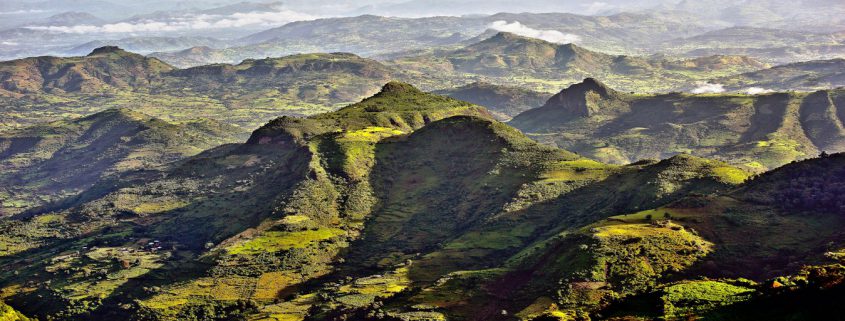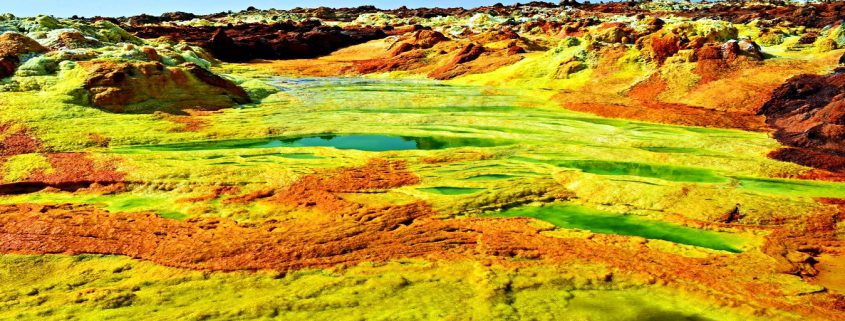SEMIEN MOUNTAIN- THE ROOF OF AFRICA
The Simien Mountain massif is a broad plateau, cut off to the
north and west by an enormous single crag over 60 kilometers long. To
the south, the tableland slopes gently down to 2,200 meters, divided by
gorges 1,000 meters deep that can take more than two days to cross. Not
enough geological time has elapsed to smooth the contours of the crags
and buttresses of hardened basalt.–Simien Mountain National Park is
located at the northern edge of the central plateau of Ethiopia,
overlooking the Tekeze Gorges. It is part of the Simien Mountain Massif
in Northern Ethiopia, which lies at elevations between about 2,000m and
4,620m, taking in Ras Dashen, the highest peak in Ethiopia, which stands
adjacent to the park and the fourth highest in Africa.–The National
Park itself, with a core area of around 140km2 and one of the smallest
in Ethiopia, is located in the North Gondar zone of the Amhara National
Regional State. It is 130 km from Gondar, the capital of North Gondar
zone of Amhara region and about 882 km from Addis Ababa. It covers the
highlands, ranging up to an altitude of 3,000 m ( with the peak of
Bwahit Mountain at 4,430 m), and the lowlands, which lie at an average
altitude of below 2,000 m. the steep escarpments separating these two
significant landscapes were formed by volcanic activities and subsequent
erosion millions of years ago. They give the mountain scenery its
characteristic appearance, which is so spectacular for visitors today.
Located at the Gondar- Axsum axis, which are both cultural world
Heritage Sites on the so-called “Historic Route, you can reach the
National Park by passing Debark, a market town on the road to Axsum and
an important base for organizing trips to the National Park.–One of the
main justifications for establishing Simien Mountains National Park at
the time was the fact that the Simien area is the last stronghold of the
Walia ibex (capra walie). This animal is a type of wild goat and the
species, found only in the Simien, is the southernmost of its genus. The
Walia habitat covers the steep areas of the escarpment as well as the
grassy ledges where they need to feed and sun themselves in mornings and
evenings. The aftermath of war, poaching, and the destruction of
natural habitat has diminished the Walia population in the park to an
alarming extent. Meanwhile efforts to protect natural habitat have shown
first signs of progress. The number of animals
still living within and around the park boundaries has increased
again from an estimated total of 200-260 in 1994 (according to Swiss
research) to 400 today. The eastern and southeastern parts of the park
around the Bwahit — steep sloping rocks over 2,400 m — are particularly
good spots to see the Walia in its natural habitat, especially in the
morning up to ten o’clock and in the late afternoon. However, not only
the Walia makes Simien Mountains National Park a world heritage site.
The Simien fox or Ethiopian wolf (canis simiensis) is another highly
endangered species endemic to Ethiopia. Until recent time, there was
controversy as to the naming of this mammal. Today research has proved
that this animal is neither a jackal nor a fox. It is rather a wolf.
Hence, it is more correct to name it as Ethiopian wolf. The population
within and around the park is estimated to be as low as 30-40, while the
estimated total in the whole of Ethiopia does not exceed much more than
400 animals, which is an indication of the threatening situation for
the Ethiopian wolf. Its habitat continues to shrink as demand grows for
the Park’s high grass. This needs great attention for conservation.
Other animals in the park are much easier to observe. It is impossible
to enter the park without passing large groups of Gelada baboons
(Theropithecus gelada).The Gelada Baboon, sometimes referred to as the
bleeding heart Baboon, because of its bare bright red chest is the third
endemic mammal of this park. With a little bit of patience and luck you
might also see the Klipspringer (Oreotragus oreotragus), the Bush pig
(Potamochoerus porcus), the Bush Buck (Tragelaphus scriptus), the
colobus (colobus abyssinicus), grass rats, and other species. –More than
180 species of birds (6 endemic in the SMNP; one discovered recently in
1998) can be found in the Simien Mountains, the most famous being the
wattled Ibis , the Lammergeier, the thick-billed Raven and the Towny
eagle. The escarpments and lowland areas in particular are ideally
suited to observing various species of Birds. –Simien Mountains National
Park is the largest virtually natural habitat island in the Ethiopian
Highlands, and its surrounding cliffs and lowlands act as an ecological
barrier allowing the ecosystems to evolve almost independently.
–Therefore, in addition to this interesting fauna, the Simien also
boasts a wealth of fascinating flora. Generally, the vegetation in the
Simien area is characterized by three different altitudinal belts. These
are Afro alpine, Ericaceous and Afromontane forest belts. –The Afro
alpine steppe belt is above 3700 m above sea level. This altitudinal
belt is famous for the occurrence of the Giant Lobelia (Lobelia
rhynchopetalum) and is rounded off with a colorful patch work of red and
yellow flowers comprising the so called ” red hot poker” (Kniphofia
Foliosa and Kniphofia pumila). This is also the belt where silvery or
yellow straw – flowers called ” Everlastings ” (eg. Helichrysum
Citrospinum) which flower in the dry season are found.–Inside the
Ericaceous belt, between elevation of 3000 and 3700m., the most
interesting is the Erica-Hypericum communities composed of the Giant St.
Johns Worth (Hypericum Revolutum) and the Giant Heath (Erica Arborea).
Another remarkable plant native to the Simien and common at this
altitude is the Abyssinian Wild Rose (Rosa Abyssinica), whose
characteristic ivory white flowers can be admired especially during the
dry season. Still in the list of exceptionally large plants at this belt
is the Giant Sphere Thistle (Echnopes Longisetus).–The belt ranging
from 2000m-3000m is called the Afro Montane forest belt. More than about
100 species of trees can be found here and the bio diversity is
generally much higher than on the highland plateau.


